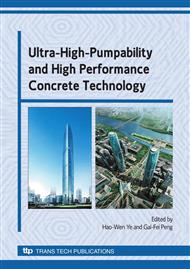[1]
G. De Schutter, L. Taerwe, Specific heat and thermal diffusivity of hardening concrete, Magazine of Concrete Research, 47 (1995) 203-208.
DOI: 10.1680/macr.1995.47.172.203
Google Scholar
[2]
E. Holt, M. Leivo, Cracking risks associated with early age shrinkage, Cement & Concrete Composites 26 (2004) 521-530.
DOI: 10.1016/s0958-9465(03)00068-4
Google Scholar
[3]
Pietro Lura, Ole Mejlhede Jensen, Autogenous shrinkage in high-performance cement paste: an ev alu ati on o f b as i c m ech ani sms, C em. Co ncr. R es. 3 3 (2 00 3) 22 3-232.
Google Scholar
[4]
Antonio Princigallo, Pietro Lura, Early development of properties in a cement paste: a numerical and experimental study, Cem. Concr. Res. 33 (2003) 1013-1020.
DOI: 10.1016/s0008-8846(03)00002-4
Google Scholar
[5]
Ole Mejlhede Jensen, Per Freiesleben Hansen, Autogenous deformation and RH-change in perspective, Cem. Concr. Res. 31 (2001) 1859-1865.
Google Scholar
[6]
Tazawa, E., Miyazawa, S., Influence of cement and admixture on autogenous shrinkage of cement paste, Cem. Conc. Res. 25(1995)281-287.
DOI: 10.1016/0008-8846(95)00010-0
Google Scholar
[7]
C. Hua, P. Acker, A. Ehrlacher, Analyses and models of the autogenous shrinkage of hardening cement paste (I. Modelling at macroscopic scale), Cem. Concr. Res. 25 (1995) 1457-1468.
DOI: 10.1016/0008-8846(95)00140-8
Google Scholar
[8]
Tazawa, E., Miyazawa, S., Experimental study on mechanism of autogenous shrinkage of concrete, Cem. Conc. Res. 25 (1995) 1633-1638.
DOI: 10.1016/0008-8846(95)00159-x
Google Scholar
[9]
Palacios, F. Puertas, Effect of superplasticizer and shrinkage-reducing amixtures on akali- activated sag pastes and mortars, Cem. Concr. Res. 35 (2005) 1358- 1367.
DOI: 10.1016/j.cemconres.2004.10.014
Google Scholar
[10]
Tazawa, E., Miyazawa, S., Influence of cement and admixture on autogenous shrinkage of cement paste, Cem. Concr. Res. 25 (1995) 281-287.
DOI: 10.1016/0008-8846(95)00010-0
Google Scholar
[11]
Qian Xiaoqian, Zhan Shulin, Fang Minghui, et al., Study and application on shrinkage- reducing agent of high performance concrete, New Building Materials, 2003, No. 7, pp.42-45.
Google Scholar
[12]
Tazawa, E., and Miyazawa, S., Autogenous Shrinkage and its Importance in Concrete, Creep and Shrinkage in Concrete-RILEM 22, ed. Z. P. Bazant and I. Carol, Proceedings from the Fifth International RILEM Symposium, Barcelona, pp.159-168.
DOI: 10.1007/bf02473431
Google Scholar
[13]
E. Holt, Early age autogenous shrinkage of concrete, PhD thesis, Seattle, University of Washington, (2001).
Google Scholar
[14]
Zhu Yaotai, Experimental investigation and theoretical modeling on early-age shrinkage cracking in concrete, Academic dissertation for master degree, Hangzhou, Zhejiang University, (2005).
Google Scholar


